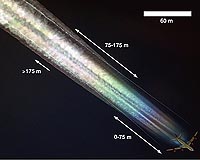| . |  |
. |
Granada, Spain (SPX) Jun 05, 2009 In the context of the climatic change of the planet, those research works that throw light on global warming are of great interest. That is the case of the studies on atmospheric aerosol, a suspension of solid or liquid particles on a gaseous environment that can contribute to the warming or cooling of the atmosphere. Juan Luis Guerrero Rascado developed his doctoral thesis "Lidar Technique for atmospheric characterization by elastic and Raman dispersion" precisely in this research line, supervised by the Professor of the University of Granada, Lucas Alados Arboledas, director of the Group of Atmospheric Physics of the Andalusian Centre for Environmental Studies, CEAMA. "The interest of studying the atmospheric aerosol resides in the fact that these particles influence enormously the radioactive balance of Earth, so that they can modify it and, according to the effects, there can be an atmospheric warming or cooling", says Guerrero Rascado.
Use and fine tuning of the LIDAR technique This technique is very similar to a radar, says the researcher, "as it consists in emitting an electromagnetic radiation, in this case laser light, which propagates in the atmosphere, interacts with the particles in suspension and afterwards, collects the radiation returned to the instrument to study from that received sign the features and the position of particles". The research work, which has required a four-year effort, was organized in three main lines: the fine tuning of the equipment; the development of algorithms for profile inversion of aerosol optical properties by active tele-detection, using the Lidar technique; an the taking of measures (from the CEAMA, in Granada) both routine and intensive campaigns of phenomenon as mineral dust intrusions from the desert of Sahara, and in the framework of programmes of validation of satellites of the NASA. The Lidar technique has been used in different countries all over the world. The station of the Andalusian Centre for Environmental Studies, in Granada, belongs to the European network EARLINET, which also interacts with a global network of solar photometry, Aeronet, coordinated by the Nasa. At present, the EARLINET network is centred on the validation of the data of the satellite Calipso, so that a monitoring of the atmospheric aerosol with vertical resolution at a global scale global can be carried out, for a better understanding of the climatic system of Earth. The authors of the article are Professor Lucas Alados-Arboledas and researchers Luis Guerrero-Rascado and Borja Ruiz Reverter. Share This Article With Planet Earth
Related Links University of Granada The Air We Breathe at TerraDaily.com
 Iridescent Ice Clouds From Aircraft Wings
Iridescent Ice Clouds From Aircraft WingsBonn, Germany (SPX) Apr 03, 2009 Not all condensation trails are the same. Scientists from the German Aerospace Center have, for the first time, been able to describe how condensation trails are created not only from the exhaust gas of jet engines but, under certain conditions, also by the wings of aeroplanes. It is unclear to what extent this new class of condensation trail influences climate change, as up until now it h ... read more |
|
| The content herein, unless otherwise known to be public domain, are Copyright 1995-2009 - SpaceDaily. AFP and UPI Wire Stories are copyright Agence France-Presse and United Press International. ESA Portal Reports are copyright European Space Agency. All NASA sourced material is public domain. Additional copyrights may apply in whole or part to other bona fide parties. Advertising does not imply endorsement,agreement or approval of any opinions, statements or information provided by SpaceDaily on any Web page published or hosted by SpaceDaily. Privacy Statement |